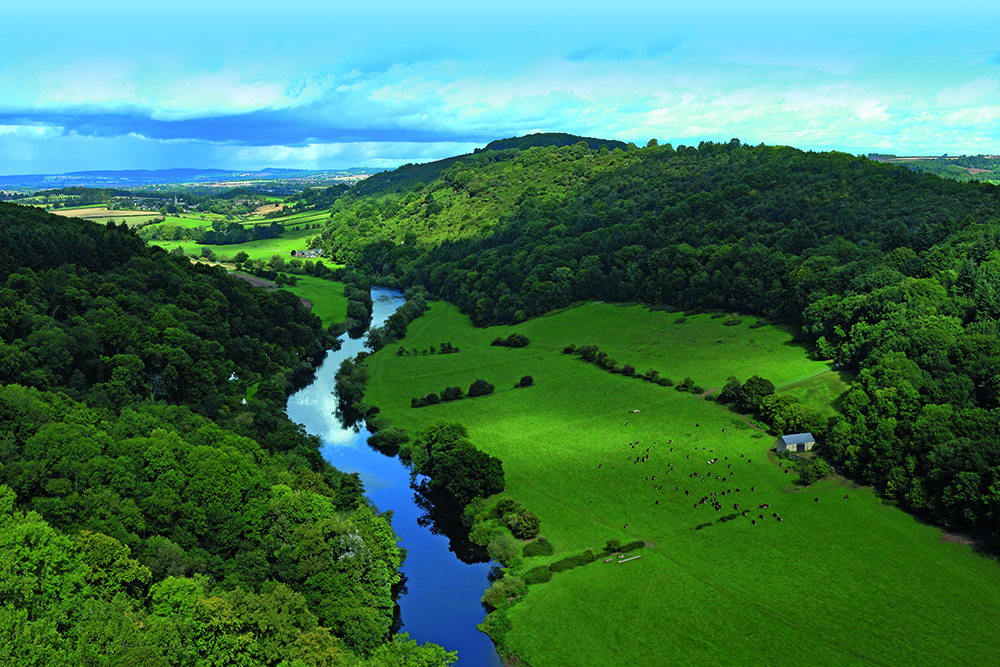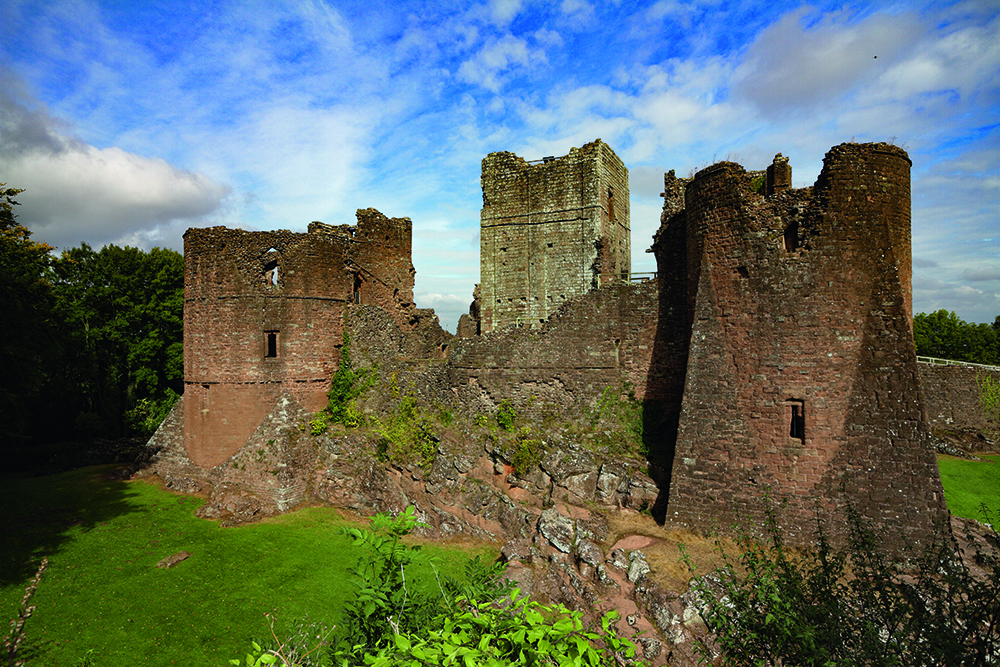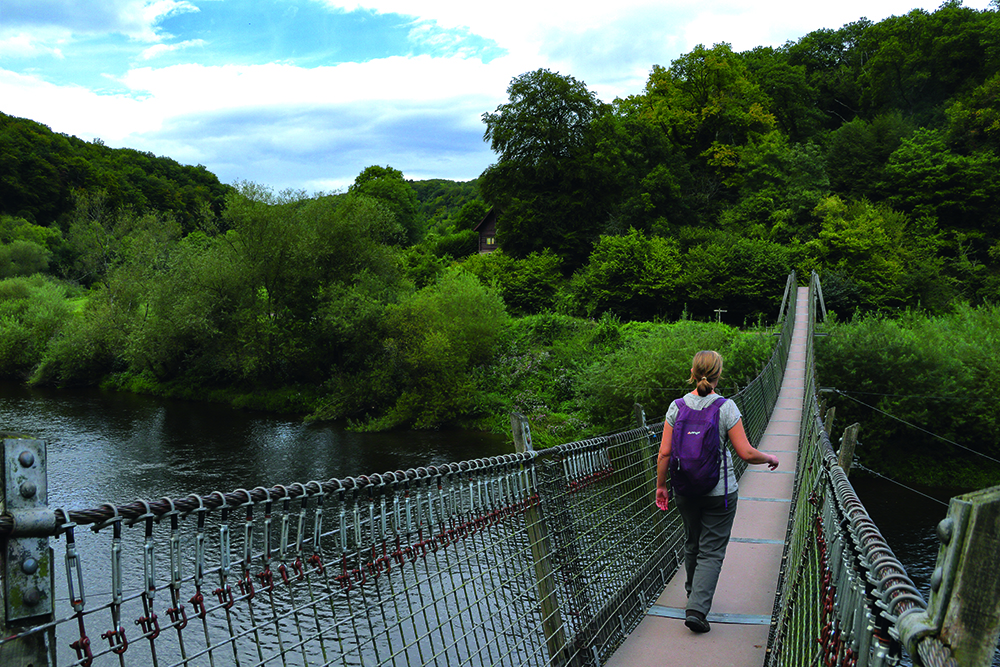Motorhome travel: Exploring the Wye Valley
The River Wye is a wandering river, full of loops as it meanders its way south between the uplands of Wales and down along the border with England. On the map it forms a twisting route that looked perfect to explore and, it turned out, one that has even been historically vouched for. We just planned to see a section of it, the steep and wooded AONB-listed lower part south of Hereford to Chepstow, known as the Wye Valley.

The river’s source is further north on the wilder peat moor sides of Plynlimon, the highest point of the Cambrian Mountains. It then wends its way for 134 miles, making it the fifth longest river in the UK. Easy to reach as a loop from the M5, which we swiftly left behind at Tewkesbury, we travelled south with its flow. We first joined the river at the market town of Ross-on-Wye.
After parking the motorhome, we walked up the rocky mound keeping the old town above floodwater. We called into shops stocked with antiques, books and tempting food and admired local arts and crafts in the red stone Market House. Here, we discovered our route (which we thought we’d ingeniously figured out ourselves), was actually the first tourist route in Britain – and Ross-on-Wye itself considered the birthplace of the British tourist industry.
Back in 1782, author and artist, William Gilpin, published the first illustrated guidebook in the country. It was based here, on local boat owners who took friends out on the river. They were there to admire the Victorian idea of the Romantic Picturesque, something with quite particular requirements. It involved nature at its most awe-inspiring yet beautiful, which was considered enhanced by decaying overgrown ruins and fierce flashes of industry – something the Wye had plenty of at the time.
Canoeing in the Wye Valley
The Wye Valley is known for the many outdoor activities it offers, including horse riding, climbing and cycling, but canoeing is its most famous... and we wanted to try it. We parked beside the river, where several canoe hire companies operate from the base of the craggy heights of Symonds Yat.
We were greeted by Nick, who gave us a safety talk which featured capsizing unnervingly frequently and was accompanied by a donning of lifejackets, maps marked with treacherous-looking red areas and watertight barrels to stop everything (except us!) getting wet if we fell in. Then we lifted the canoes onto a trailer and Nick drove us the short road journey upstream to Kerne Bridge. He pointed out that canoeing here is popular as the river is freely navigable (so requires no licence), the water steady enough for beginners and, most of all, the scenery is lovely, complete with high limestone gorge.
As we meandered, capsize-free, for the eight miles of our trip downstream, we saw two kingfishers darting along ahead of us between the willows. Approaching Welsh Bicknor, the church spire led us to the youth hostel in the old rectory, where we heaved the canoe ashore and went to the café with its terrace overlooking the valley. The last section of the journey passed through the craggy gorge, where birds of prey flew in the hazy light overhead.
Finally, we crunched onto the earthy gravel of the riverbank where a couple helped us heave our canoe out of the water for the last time. We returned for a second night to the peaceful Elmsdale campsite and, in the evening, set off across the fields to Goodrich village and its cosy pub and castle.
Exploring the Wye Valley's history
Goodrich Castle, built of carved red sandstone and sitting on an outcrop overlooking the river, was completed in the thirteenth century by William de Valence, the French uncle of castle-building Edward I. It was a sign to untrusting locals of his taste and connections and that this was his home and that he wasn’t going to be moved. Apparently, in its day, the masonry work was considered very fashionable.
Understandably a bit worn eight centuries and a civil war later, the castle still stands relatively complete with towers and ramparts and a deep moat which tempted children to clamber up its sides, often pursued by their parents. We didn’t have that excuse; we contented ourselves with reading historical labels and admiring the view before heading back to the campsite.
At Symonds Yat Rock, immediately above where we’d passed in our canoe, sits an Iron Age hill fort. For centuries this was an important defensive position; the Romans were here and the eighth century earthwork Offa’s Dyke passes nearby. In the seventeenth century the local Symonds family collected tolls on the river at the foot of the rock (‘yat’ meaning gateway). The reason is that it’s at the top of a very steep climb, which we chose to leave for later, parking right at the top.
We headed first to the spectacular viewpoint. An almost sheer cliff plunged down beside us. We gazed from a rocky balcony, the river wrapped around the cliff’s base, wide and reflecting the sky. Woodland folded round huge pillars of rock to one side and, in the distance, a herd of brown cows wandered gradually to water over a sweeping green field. Two people we recognised from the campsite said they had been there for hours, watching the birds and looking for the peregrine falcons and goshawks which are frequently here.
We wandered into the woods to join one of the trails to the river. The surrounding mixed woodland was bright with mosses and ferns. Wild boar live here and I noticed their heavy-hooved footprints and the give-away of turned-over earth. Descended from farm escapees 20 years ago, they are a native species and so do very well rooting amongst the loamy forest floor.
Wandering through the Wye Valley's woodlands
Back in Symonds Yat East, people were taking boat rides and wandering into tearooms. We finally completed the short steep hike back to the motorhome, spurred on once we remembered the tea cabin at the top. A little further along the river, we called in at Redbrook, a small village that had once supported 13 pubs and three breweries. One of a few remainders is the Boat Inn, which we found by walking across a high old railway bridge over the river. We sat by the water’s edge, considering how the village had come to get its name from staining by the iron ore once brought here for the village’s metalworks.
Our stop that night was at Beeches Farm, a friendly campsite on a working farm and offering a wonderful view over the valley. In the morning we set off early, walking through what are considered some of the most important woodlands in Britain. The same species are here as would have been found in the natural woods that once covered the country.
A plaque beside the path told us that we’d reached the Devil’s Pulpit – a narrow pillar of rock in a gap in the trees and from where we could see Tintern Abbey far below. The legend goes that the devil had yelled down temptations at the monks to encourage them to leave their monastic life, but it was actually Henry VIII’s dissolution of the monasteries that led to the abbey falling into ruin.
A steep path down took us directly to the abbey, which stands impressively as the best-preserved medieval abbey in Wales. We continued through Tintern village and stopped at the Old Station Café for lunch. Another present success of the old railway line, it forms a popular park on the now grassy platform.
The charms of the sculpture trail and playground were not lost on us, though the Kingstone Brewery across the road drew us away eventually. The brewer gave us a couple of samples and told us how the range of beers are traditionally made on site. Our walk back up the steep hill was much harder with the gained weight from the bottles we’d bought. We enjoyed them sitting outside the ’van as we watched the sunset colours shift on the campsite’s huge beech trees.
Crossing the Severn Bridge on our way home the next day and catching a glance as the Wye merged into the estuary beneath us, it occurred to me that, with the Wye Tour, successful industries, railway trips and, of course, today’s canoeing, this valley has an endless stream of heydays.








.jpg)


Recent Updates
Engine management lights: all you need to know
What is the engine management light? What does it mean, and what do I have to do? ...
Motorhome air suspension: all you need to know
Motorhomes are heavy and the additional weight of equipment and height of the bodywork can increase the loads ...
Motorhome WiFi: how to get better motorhome internet
Staying connected on the move is more and more essential, so relying on campsite WiFi isn't an option – here ...
A class of their own - our guide to A-class motorhomes
Thinking of trading up to an A-class, or even going straight to the top of the motorhome tree? We guide you ...
Explore overseas on a motorhome dream tour
Enjoy exotic travel in a campervan or motorhome by hiring, swapping with someone else or exporting your ...
Motorhome water systems: everything you need to know
On-board water is an important part of every motorhome – here’s everything you need to know ...
Campervanning in Europe: what you need to know
Whether you're planning a leisurely drive through the French countryside, navigating bustling city streets in ...
Campervan security: all you need to know
With thefts on the increase, it’s important to know how to keep your campervan secure and prevent campervan ...
Campervan furniture: everything you need to know
Our campervan experts guide you through all the essentials for your campervan, including tables, chairs, ...
Campervan finance: how to fund your purchase
Here we look at the different types of campervan finance available, to help you decide what’s the best option ...
Other Articles
Britain’s best used motorhomes
Want a great motorhome without paying the premium for a new one? Here's a guide to the best you can get in the pre-owned market for each layout, ...
Which motorhome? Choosing the perfect motorhome for you
Choosing a motorhome or campervan is one of the biggest buying decisions you’ll ever make, so it's important ...
Campervan washroom essentials: stay fresh on the road
Our guide will take you through the campervan washroom essentials you'll need so you're well-prepared for ...
Dogs in campervans: all you need to know
Follow our advice and your dog will enjoy campervanning as much as you do ...
Electric campervans: all you need to know
Our guide will take you through everything you need to know about electric campervans and what the future ...
Motorhome electrics: a complete guide to your motorhome electrical set-up
Motorhome electrics can dramatically enhance the convenience and comfort of your vehicle – but they can be ...
Lighting for campervans: all you need to know
We guide you through all the lighting options available for you and your campervan, including interior ...
Electric bikes for motorhomes: our ultimate guide
Read our comprehensive guide to electric bikes for motorhome owners, helping you add electric power to your ...
Our guide to 'cheap' motorhomes in 2024
If you're on the hunt for an affordable new motorhome, this is the best place to start – we've rounded up a ...
Campervans in winter: all you need to know
Here's your guide to preparing your campervan for the colder months, whether you will be using it or putting ...